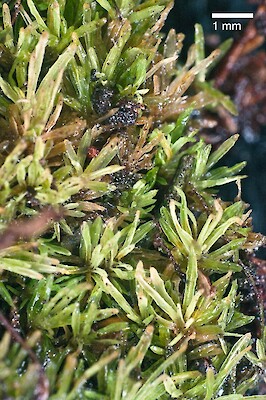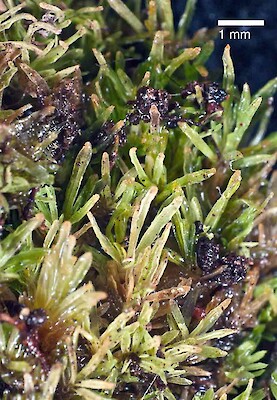image from: https://www.researchgate.net/figure/Syrrhopodon-croceus-Mitt-A-Habit-of-plants-drawn-moist-B-D-Leaves-E-Cells-of-leaf_fig6_371413539
Introduction
Welcome, fellow moss enthusiasts! Today, we’re going to delve into the fascinating world of Syrrhopodon croceus Mitt., a captivating moss species from the Calymperaceae family, also commonly known as Syrrhopodon. Prepare to be enchanted by this tiny, yet remarkable, member of the Bryophyta (mosses) division.
Background
Before we dive into the details, let’s set the stage.

image from: https://www.nzpcn.org.nz/flora/species/syrrhopodon-armatus/
Bryophytes

image from: https://www.earth.com/plant-encyclopedia/Bryophytes/Calymperaceae/syrrhopodon-prolifer/en/
, including mosses, liverworts, and hornworts, are among the oldest and most primitive land plants on our planet. These resilient organisms have been around for millions of years, playing crucial roles in various ecosystems and serving as important indicators of environmental health.
Main Content
Morphology and Identification
Syrrhopodon croceus Mitt. is a striking moss species that boasts a vibrant golden-yellow color, earning it the epithet “croceus,” which means “saffron-yellow” in Latin. This eye-catching hue is due to the presence of unique pigments that help protect the moss from harmful UV radiation. The plants form dense, cushion-like tufts or mats, with slender, erect stems and small, overlapping leaves.

image from: https://www.nzpcn.org.nz/flora/species/syrrhopodon-armatus/
One of the key identifying features of Syrrhopodon croceus Mitt. is its distinctive leaf shape. The leaves are lanceolate (lance-shaped) and acuminate (tapering to a slender point), with a prominent midrib running along their length. Under a microscope, you’ll notice that the leaf cells are

image from: https://www.researchgate.net/figure/Syrrhopodon-armatus-Mitt-A-Plant-B-Leaves-C-Basal-part-of-leaf-D-Cross-section-of_fig2_283888063
elongated and thick-walled, contributing to the moss’s resilience.
Global Distribution and Habitat
Syrrhopodon croceus Mitt. is widely distributed across tropical and subtropical regions, thriving in a variety of habitats. You can find it growing on tree trunks, rocks, and even soil in moist, shaded areas of forests, woodlands, and urban environments. This moss is particularly abundant in regions with high humidity and moderate temperatures, such as Southeast Asia, Central and South America, and parts of Africa.
Ecological Roles and Adaptations

image from: https://www.researchgate.net/figure/Syrrhopodon-armatus-Mitt-A-Plant-B-Leaves-C-Basal-part-of-leaf-D-Cross-section-of_fig2_283888063
Despite their diminutive size, mosses like Syrrhopodon croceus Mitt. play vital roles in their ecosystems. They act as pioneers, colonizing bare surfaces and facilitating the establishment of other plant species. Additionally, they contribute to soil formation, water retention, and nutrient cycling, making them essential components of healthy ecosystems.
One of the remarkable adaptations of

image from: https://bryophyteportal.org/frullania/taxa/index.php?taxauthid=1&taxon=Syrrhopodon&clid=164
Syrrhopodon croceus Mitt. is its ability to tolerate desiccation. During dry periods, the moss can enter a state of dormancy, curling up its leaves and slowing down its metabolic processes. When moisture returns, it quickly revives, showcasing its incredible resilience.
Case Studies/Examples
In a recent study conducted in a tropical rainforest in Malaysia, researchers found that Syrrhopodon croceus Mitt. was one of the most abundant moss species growing on tree trunks. Its vibrant golden hue added a striking visual element to the forest understory, attracting the attention of nature enthusiasts and photographers alike.
Technical Table

image from: https://enciclovida.mx/especies/136784-syrrhopodon
image from: https://botanyprofessor.blogspot.com/2013/12/mosses-of-central-florida-5-syrrhopodon.html
| Characteristic | Description |
|---|---|
| Scientific Name | Syrrhopodon croceus Mitt.
 image from: https://www.earth.com/plant-encyclopedia/Bryophytes/Calymperaceae/syrrhopodon-parasiticus/en/ |
| Family | Calymperaceae |
| Common Name | Syrrhopodon |
| Growth Form | Dense cushions or mats |
| Leaf Shape | Lanceolate, acuminate |
| Leaf Cells | Elongated, thick-walled |
| Color | Golden-yellow |
| Habitat | Tree trunks, rocks, soil (moist, shaded areas) |
| Distribution | Tropical and subtropical regions |
| Ecological Roles | Pioneer species, soil formation, water retention, nutrient cycling |
| Adaptations | Desiccation tolerance, pigment protection |